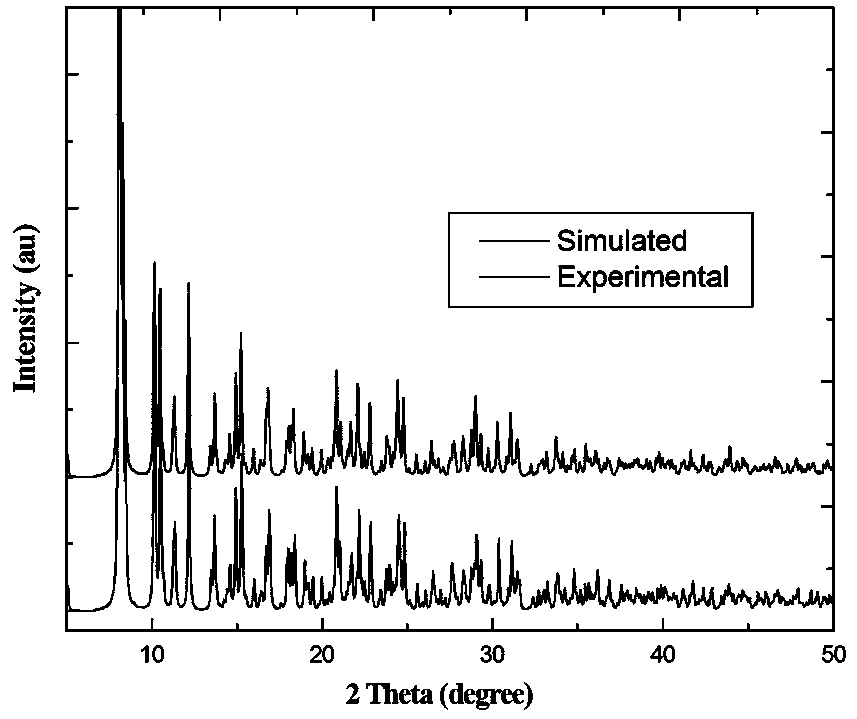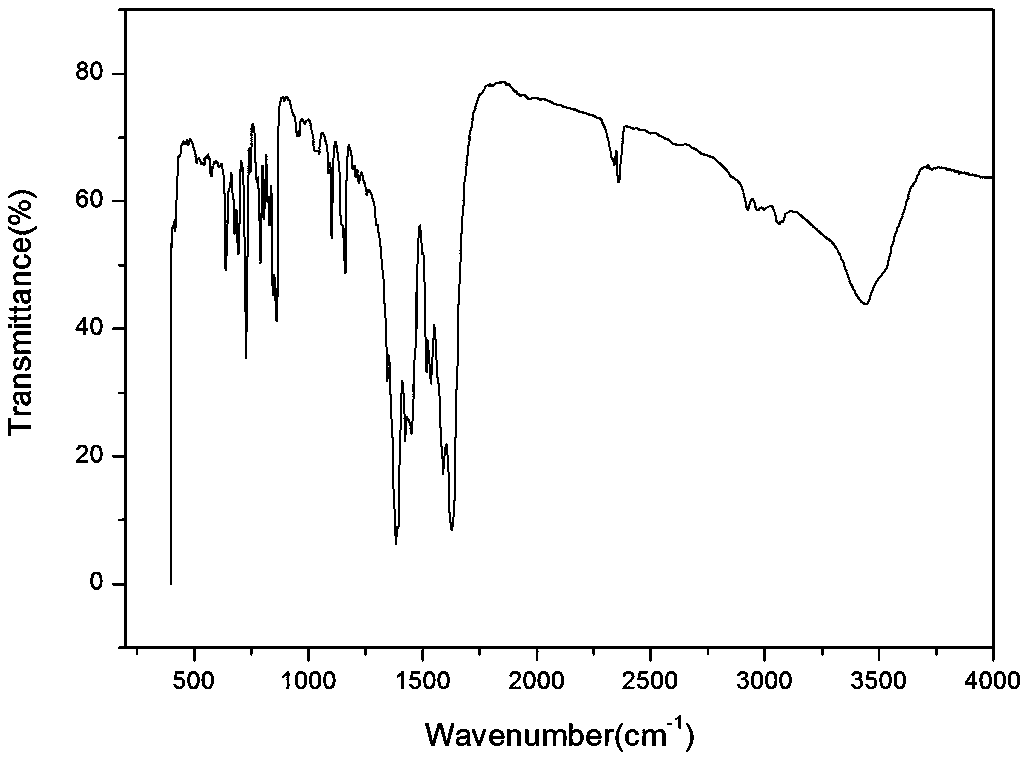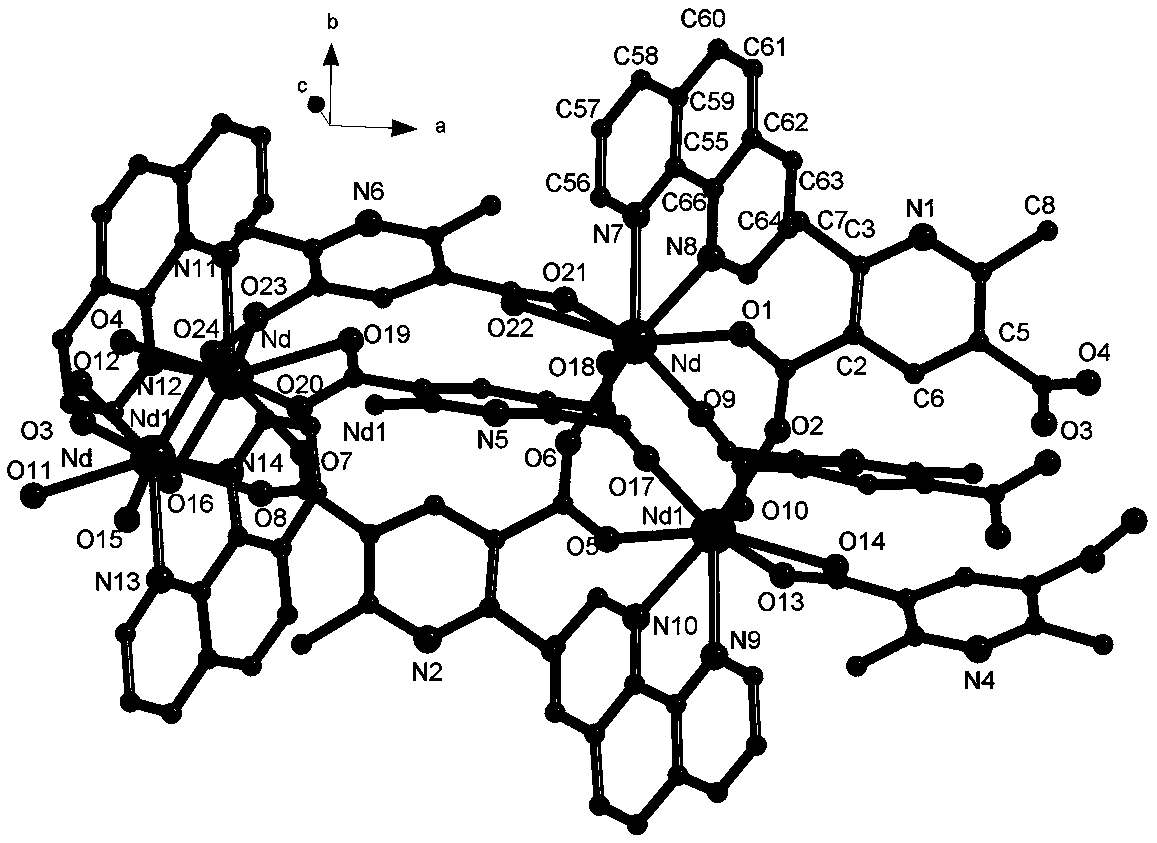Nd compound luminescent material containing phenanthroline and modified carboxylate ligand and preparation method of Nd compound luminescent material
A luminescent material, phenanthroline technology, applied in the field of Nd compound luminescent material and its preparation, to achieve the effect of increased fluorescence efficiency, low raw material cost, and prolonged luminescent life
- Summary
- Abstract
- Description
- Claims
- Application Information
AI Technical Summary
Problems solved by technology
Method used
Image
Examples
Embodiment 1
[0021] a. Add 2,6-lutidine-3,5-dicarboxylic acid and 1,10-phenanthroline into distilled water, stir and dissolve, add dilute glacial acetic acid solution to adjust the pH to 4.0 to obtain a solution of organic ligands, spare;
[0022] b. Add the organic ligand solution to the mixture of water and organic solvent, then add Nd(NO 3 ) 3 ·6H 2 O, stir under normal temperature and pressure to obtain the precursor solution, for subsequent use;
[0023] The volume ratio of water and organic solvent in the mixture of water and organic solvent is 1:1, and the organic solvent is DMSO.
[0024] per 0.1mol organic ligand H 2 Add 0.02mol of Nd(NO 3 ) 3 ·6H 2 O.
[0025] c. Move the precursor solution to a polytetrafluoroethylene-lined hydrothermal reaction kettle, seal it in a stainless steel reaction kettle, put it in an oven, adjust the temperature of the oven to 160°C, and react for 80 hours. After the reaction is completed, control the reaction kettle Cool to room temperature ...
Embodiment 2
[0032] a. Add 2,6-lutidine-3,5-dicarboxylic acid and 1,10-phenanthroline into distilled water, stir to dissolve, add dilute glacial acetic acid solution to adjust the pH to 3.0, and obtain an organic ligand solution for later use ;
[0033] b. Add the organic ligand solution to the mixture of water and organic solvent, and then add Nd 2 o 3 , stir under normal temperature and pressure to obtain the precursor solution, and set aside;
[0034] The volume ratio of water and organic solvent in the mixture of water and organic solvent is 0.1:1, and the organic solvent is ethanol.
[0035] per 0.1mol organic ligand H 2 Add 0.01mol of Nd to dpda 2 o 3 .
[0036] c. Move the precursor solution to a polytetrafluoroethylene-lined hydrothermal reaction kettle, seal it in a stainless steel reaction kettle, put it in an oven, adjust the temperature of the oven to 135°C, and react for 100 hours. After the reaction is completed, control the reaction kettle Cool to room temperature at ...
Embodiment 3
[0038] a. Add 2,6-lutidine-3,5-dicarboxylic acid and 1,10-phenanthroline into distilled water, stir and dissolve, add dilute glacial acetic acid solution to adjust the pH to 5.0, and obtain an organic ligand solution for later use ;
[0039] b. Add the organic ligand solution to the mixture of water and organic solvent, then add Nd(CH 3 COO) 3 ·5H 2 O, stir under normal temperature and pressure to obtain the precursor solution, for subsequent use;
[0040] The volume ratio of water and organic solvent in the mixture of water and organic solvent is 2:1, and the organic solvent is DMF.
[0041] per 0.1mol organic ligand H 2 Add 0.015mol of Nd(CH 3 COO) 3 ·5H 2 O.
[0042] c. Move the precursor solution to a polytetrafluoroethylene-lined hydrothermal reaction kettle, seal it in a stainless steel reaction kettle, put it in an oven, adjust the temperature of the oven to 180°C, and react for 60 hours. After the reaction is completed, control the reaction kettle Cool to room...
PUM
 Login to View More
Login to View More Abstract
Description
Claims
Application Information
 Login to View More
Login to View More - R&D
- Intellectual Property
- Life Sciences
- Materials
- Tech Scout
- Unparalleled Data Quality
- Higher Quality Content
- 60% Fewer Hallucinations
Browse by: Latest US Patents, China's latest patents, Technical Efficacy Thesaurus, Application Domain, Technology Topic, Popular Technical Reports.
© 2025 PatSnap. All rights reserved.Legal|Privacy policy|Modern Slavery Act Transparency Statement|Sitemap|About US| Contact US: help@patsnap.com



